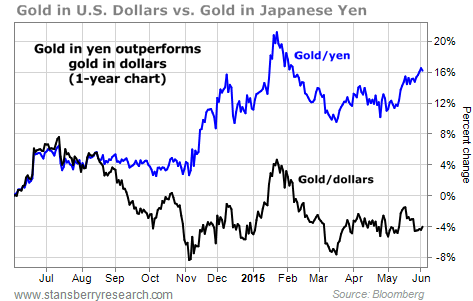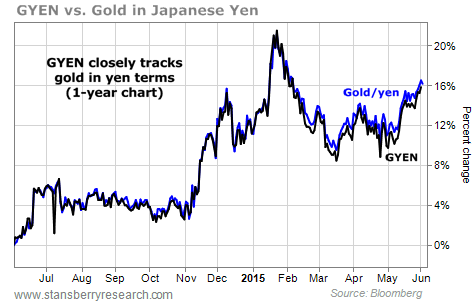| Home | About Us | Resources | Archive | Free Reports | Market Window |
One of the Best Currency Trades You Can Make TodayBy
Wednesday, June 3, 2015
The U.S. dollar is in danger because our government is in too much debt.
The U.S. dollar is in danger because our politicians are acting recklessly.
If you've read a financial newspaper or watched financial news in the past five years, you know why some folks believe the U.S. dollar will decline in value over the coming years.
Now, take those reasons and double their power...
... And you'll see why the Japanese yen is in danger... and why you should bet on it falling.
We have a unique way for you to do it today.
One of our main goals in our DailyWealth Trader service is to share ideas and insights from some of the world's best investors and traders.
Today, we're sharing an idea from one of the most widely followed traders in the world... Dennis Gartman.
Dennis Gartman writes an excellent daily newsletter – The Gartman Letter – which covers all the major financial markets. Stocks, bonds, currencies, real estate, commodities... Gartman covers them all and provides actionable trading recommendations based on his analysis. Many of the world's top financial firms consider Gartman's letter "must read" material.
(Gartman's letter isn't cheap... but it's a fantastic daily read. If you're controlling a large investment stake, it's well worth the cost. You can learn more about a subscription at www.thegartmanletter.com.)
As we mentioned, many people believe the U.S. dollar is in danger because of the debt and obligations the government has taken on. But the government of Japan has taken on much more debt... and put its currency in much more danger.
A country's debt-to-gross-domestic-product (or debt-to-GDP) ratio shows how much debt it has relative to its annual economic production. The U.S. debt-to-GDP ratio is 103% (meaning the national debt is 3% larger than the annual economic output)... The Japanese debt-to-GDP ratio is 227% (meaning its debt is more than twice the size of its annual economic output).
In other words, the U.S. has problems... but Japan has much bigger problems. And that means problems for its currency, the yen.
A nation's currency is like a rough "stock price" of that nation. Generally speaking, if a country manages its finances well and engages in productive behavior, its currency appreciates over the long term. If a country racks up crazy debts and runs its finances like a drug addict, its currency depreciates over the long term.
Like almost any government throughout history, Japan's government plans to lessen its debt burden by devaluing its currency. It plans to pay its obligations with devalued money.
Over the past three years, it has been successful at carrying out its plan. The Japanese yen has fallen in value by 38% since mid-2012. Because Japan's debt burden is so high, you can expect the yen to fall even more in the coming years.
And as a currency falls, the price of gold in that currency usually rises.
As we explained in last week's DailyWealth, we think gold has bottomed and is likely to rise in the years ahead. But even if gold simply treads water in U.S. dollars (as it has done for the past couple years), there's a good chance it will still rise in yen.
And that's exactly what it has done. The chart below shows the change in the price of gold in U.S. dollars (the black line) and the change in the price of gold in Japanese yen (the blue line). You can see that gold fell 4% for U.S. investors over the past 12 months... And it rose 16% for Japanese investors.
 But you don't need to live in Japan to take advantage of this trend. About a year ago, Gartman worked with a financial firm to create a one-click way to "buy gold in yen terms" – the AdvisorShares Gartman Gold/Yen Fund (GYEN). The fund has a reasonable annual fee of 0.65%... And as you can see in the chart below, it does a great job of tracking gold's price relative to the yen. The black line shows the change in GYEN over the past year. The blue line, again, shows the change in gold relative to the yen.
They're each up about 16%.
 The minor difference in returns is mostly due to the annual fee. Today, we recommend you take advantage of two trends that are likely to play out over the next year: rising gold prices and a falling yen. Gartman's fund is a simple way to do both.
You could make double-digit annual returns over the next few years as gold rises and the yen falls. It's one of the best currency trades you can make right now.
Regards,
Brian Hunt and Ben Morris
Further Reading:
"Dramatic changes are coming to the world's monetary system this October," Steve Sjuggerud writes. "One of the most powerful organizations on Earth will make an official announcement... and it will likely kick off one of the largest transfers of money out of U.S. dollars in our lifetimes." Get all the details of this coming event here and here.
Most people don't know currencies can affect their trading. But Ben says if you're buying foreign stocks – even with exchange-traded funds – currency moves can be a major tailwind, which adds to your profits... or a significant headwind. "Either way, you need to know what you're dealing with," he writes. Learn more here.
Market NotesTHE GREAT BEAR MARKET IN COAL Today's chart looks at the epic collapse in the coal sector...
Over the past five years, being long coal producers has been a painful bet. Tighter regulations and cheap natural gas prices have crushed coal demand. China, which accounts for half of global consumption, is also cutting back on coal imports. China's coal imports from the first quarter this year were 42% lower compared with the same quarter last year.
The result has been a huge bear market in the coal sector. According to the U.S. Energy Information Administration, U.S. coal production will drop to a 30-year low in 2015.
You can see how bad it has gotten in the chart below. It shows the last year's share-price action in the Market Vectors Coal Fund (KOL)... a fund that holds a basket of coal producers and related stocks. Since last September, KOL is down more than 30%... and just broke down to its lowest point in more than six years. As you can see, it's a steady bear market in coal...
 |
Recent Articles
|



